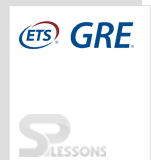The verbal section checks the understanding of reading comprehension and reasoning in a multiple-choice format. The section tests the ability to form relations and contemplate day-to-day situations between the given information, and the provided information may be in the form of words, concepts or sentence.
The test takers should have enough knowledge of the subject and also be alert and watchful with a specific end goal to discover the difference or similarities in the given data and concepts.
The test taker needs to review and analyze the written material to combine the information and to check the connection between the different sentence elements. The test takers need to read the given passages and answer the questions given under those passages.
GRE Quant contains 2 math sections, each containing about 20 questions, and each 30 minutes long.
| No of sections |
Questions per section |
Time per section |
| 2 sections |
20 questions per section |
30 minutes per section |
The Verbal section consists of only three types of questions and they are designed to test the ability of a test taker to solve problems, not the mathematical knowledge.
Text Completion -
Expert readers don’t merely absorb the information presented on the page; instead, they maintain a relentless perspective of interpretation and analysis, reasoning from what they have read so far to create a picture of the whole and revising that picture as they go. Text Completion questions check this ability by omitting crucial words from short passages and asking the test taker to use the remaining info within the passage as a basis for selecting words or short phrases to fill the blanks and build a coherent, purposeful whole.
The passage composed of one to five sentence, provided with one to three blanks and each blank have three answer choices and sometimes five answer choices are provided in case of a single blank and these answer choices for different blanks functions independently, which mean the test takers can select one answer choice for one blank and the choice will not affect another blank choice.
Sentence Equivalence -
The section check the ability of a test taker to reach a conclusion about how a passage should on the basis of partial information, the section consists of a single sentence with just one blank and ask the test taker to find two choices that lead to complete, coherent sentence while producing the sentences that mean the same thing. So, two answer choices are mandatory and no credit for the partially correct answer.
Reading Comprehension -
The questions in this section are designed to check the ability of a test taker that are required in order to read and understand the kind of prose commonly encountered in graduate school. Following are the abilities included:
- Finding the difference between the minor and major points.
- Analyzing the meaning of each word and sentence.
- Analyzing the meaning of each paragraph and large text bodies.
- Deriving the conclusion from the provided information.
- Understanding a text and reaching conclusion about it.
- Pointing the weakness and strength of a position.
The Reading Comprehension consists two types of questions:
Multiple choices – select one answer Choice
These are the regular multiple choice questions provide with five answer choices, the test takers should select one choice out of them.
Multiple choices – select one or more answer choices
These are the question provided with three answer choices and the test takers are asked to select all that are correct answers; one, two or all the three answer choices may be correct. To gain a credit all the three choices should be correct and no credit for partially correct answers.
Topics -
The test taker is given with 10 passages of varying lengths and the subject material in the passages are expected from following concepts:
- Physical sciences
- Biological sciences
- Social sciences
- Business
- Arts
- Humanities
Other everyday material found in academic and non-academic books and periodicals.
Test takers are required to have good knowledge and understanding in various subjects and current affairs.
 Introduction
Introduction 




